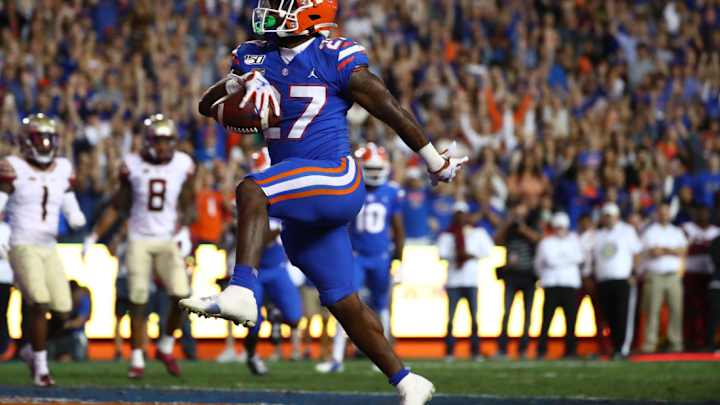Projecting the Florida Gators 2020 Fall Camp RB Depth Chart

After what feels like the longest offseason in recent memory, the Florida Gators are set to kick off their fall football camp this Friday, August 7th.
Until then, we'll be projecting the Gators' depth chart, position by position to familiarize fans with the roster that head coach Dan Mullen and staff yield this year. We have already gone over the quarterbacks, now it's time to take a look at one of the team's most fluid position groups, especially near the bottom.
Earlier this year, the Gators lost their bell-cow running back in Lamical Perine to the NFL Draft. Perine was selected in the fourth round by the New York Jets. With that, the Gators will have to look on their depth chart in an effort to replace him.
Coming into the year the Gators ranked No. 117th in rushing yards per game with 118.1, a stark contrast from what Gators head coach Dan Mullen was accustomed to at Mississippi State.
While the Gators did not sign a running back in the 2020 recruiting class (Zach Evans ultimately went to TCU), under running backs coach Greg Knox, they did lure Miami-transfer RB Lorenzo Lingard to Gainesville, he has since been granted eligibility.
1. Dameon Pierce
Pierce, entering his junior season with the Gators, played behind Perine for his previous two seasons with the team and is looking to make a push for the starting gig during fall camp and as the Gators progress into what will be a challenging season.
In his career, Pierce has accounted for 123 rushes for 729 yards and six touchdowns, finishing as the team's second-most productive back on the roster. In total, he's made 25 appearances and had a career-high performance with 87 rushing yards and a touchdown against South Carolina.
Pierce has bided his time behind Perine, but now his time to shine is quickly approaching as the team's most experienced running back besides Malik Davis. With a combination of size, 5-foot-10, 207 pounds and speed, he should threaten any defense he comes in contact with.
2. Lorenzo Lingard
While it is still very early, Lingard looks to make a major difference in the Gators' passing game this season. Transferring out of Miami after an injury left him sidelined, and ultimately redshirted, the Orange City (Fla.)-native opted to transfer out of Miami for a fresh start. He is now heading into his redshirt sophomore season.
Lingard entered his collegiate career as a five-star running back, demonstrating blazing speed and a knack for catching the football. Prior to his injury at Miami, Lingard accounted for 17 rushes for 136 yards and two touchdowns through six games prior to his injury. He played in only two games last season, primarily on special teams before redshirting.
Florida will hope the 6-foot-0, 200-pound running back can make a difference on passing downs as he once was able to in high school. In 2016, Lingard accounted for 1,418 yards and 22 rushing touchdowns.
3. Malik Davis/Nay'Quan Wright
This is where the depth chart gets a bit tricky, and really both Wright and Davis will have an opportunity to vie for the primary backup position depending on how things shake out with Lingard returning after so much playing-time off.
Davis has been with Florida since 2017, falling victim to injuries and has never really been able to establish himself within the Gators' offense. Over the course of his career, Davis has accounted for 125 rushing attempts for 673 yards and three touchdowns.
If Davis were to stay healthy, he'd be in a great position to be the team's third running back, however Wright has a case to make as well.
Entering his second season with the team, Wright will need to show Florida's staff he has what it takes to receive serious playing time in case of injury, however, he has plenty of the pedigree to demonstrate just that. Recruited out of Opa Locka (Fla.), Wright is a smaller back, 5-foot-9, 195 pounds, who works perfectly as a utility or outlet back in the Gators' backfield.
While Davis certainly has a bit of an edge here, don't be surprised to see Wright earning much more playing time heading into his redshirt freshman season.
4. Iverson Clement
As stated previously, the depth chart near the bottom for the Gators is a tough call, Clement will certainly have a path upwards if he were to perform well between now and the start of the season. In a coin-toss, Wright finished ahead due to having more carries (12) last year than Clement has had in his career thus far (7).
Signing with the Gators in Mullen's first recruiting class (2018), Clement has been primarily a special teams player, earning only seven carries for 65 yards over the past two years. Entering his redshirt sophomore season, Clement looks to earn an edge, vying for playing time while still excelling on special teams.
Final Thoughts
The Gators' running back depth chart features a lot of unknowns. Really, the only rock-solid placement is Pierce, the rest will be left up to how a player feels and performers heading into the season. Last year Perine earned 132/235 (56% ) of the rushes among all running backs, and the same - or perhaps more -, will likely be said for Pierce and company when it's all said and done.
While the future is muddy for the Gators at running back, the present isn't all doom and gloom. There's plenty of talent on the roster, and with not much tread on their tires, it could be a big year for the Gators and their running game.

Demetrius Harvey is a beat writer covering the Florida Gators, including football, basketball and recruiting. He currently serves as the deputy editor of Sports Illustrated - AllGators. Demetrius also covers the Jacksonville Jaguars for Vox Media. Follow Demetrius on Twitter at @Demetrius82.
Follow Demetrius82